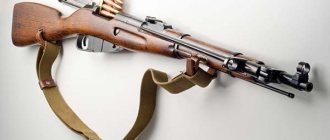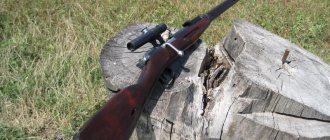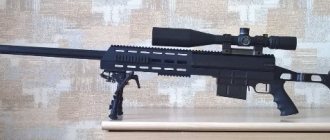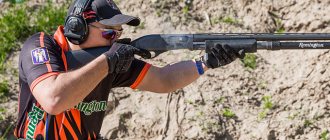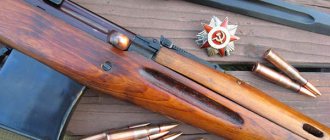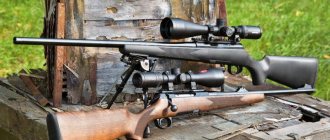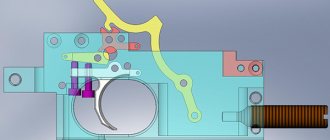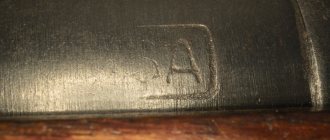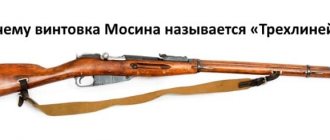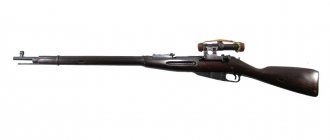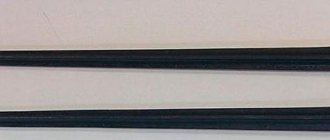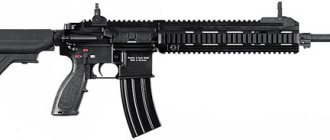Mosin, Mendeleev, Rogovtsev and Nagan who joined them
In the Balkans at the end of the century before last, the Russian army was still fighting with “berdankas” - single-shot rifles developed by the American Colonel Hiram Berdan, when in the West they were already experimenting with repeating repeater rifles. And finally, in 1887, fulfilling the task of the Main Artillery Directorate, the head of the tool workshop of the Tula Arms Plant, Staff Captain Sergei Ivanovich Mosin, created a rifle with a rack magazine in the butt, initially with 8, later with 12 rounds. By that time, the officer already had the Mikhailovsky Artillery Academy under his belt, from which he graduated with a gold medal.
But a truly modern rifle was created only after Dmitry Mendeleev received high-quality smokeless gunpowder, and Colonel N.F. Rogovtsev developed a 7.62 mm cartridge that had a bullet in a nickel silver jacket, which did not wear out the barrel so much.
A sample of a multi-shot rifle by staff captain Sergei Mosin, presented in 1889 to a special commission, competed with the rifle of the Belgian Leon Nagan. During military trials in the fall of 1890, 300 Mosin rifles and 300 Nagant rifles took the combat test. During the shooting, the Mosin rifles had 217 delays when feeding cartridges from the magazine, and the Nagan rifles had three times more delays. Tests have shown that the Russian rifle, although inferior to the Belgian one in finesse and design, has an advantage in reliability and ease of manufacture. However, in the end, Mosin’s sample was accepted only as a basis. It was necessary to make modifications to it both from the Nagan design and those proposed by the specialists who were part of the commission.
© Photo from the archive In 1887, the head of the tool workshop of the Tula Arms Factory, Staff Captain Sergei Ivanovich Mosin, created a rifle with a rack-and-pinion magazine in the butt, initially with 8, later with 12 rounds.
Minister of War Pyotr Vannovsky, presenting the final version for approval to the emperor, wrote: “The new model being manufactured contains parts proposed by Colonel Rogovtsev, the commission of Lieutenant General Chagin, Captain Mosin and gunsmith Nagan, so it is advisable to give the developed model a name: Russian 3-linear rifle model 1891." Alexander III spoke more lapidarily - “a three-line rifle of the 1891 model.” The “three-line” was officially adopted by the Russian army on April 16, 1891.
Reference
The name “three-line” comes from the caliber of the rifle barrel, which is equal to three lines. A line is an obsolete measure of length equal to approximately 2.54 mm. In other words, the term “three-ruler” means the well-known and familiar 7.62 mm caliber.
Interesting historical perspective. Information about the new Russian rifle quickly spread abroad. A Russian military agent in London reported to St. Petersburg that British intelligence managed to obtain a rifle of the 1891 model, and now it is being carefully studied in Britain. The US War Department expressed a desire to adopt the three-line rifle, and the Serbian government asked for permission to order the production of Russian rifles for its army at French factories.
© wikipedia.org
The building of the main building of the Tula Emperor Peter the Great arms factory. Celebrations in 1912 on the occasion of the 200th anniversary of the plant's existence.
Sergei Ivanovich Mosin was not overlooked by ranks and awards, but he was worried that his rifle did not bear his name. By the way, at the proposal of the Minister of War, Mosin was given a bonus of 30 thousand rubles, and Nagan, apparently, as a foreigner - 200 thousand. The name Mosin was finally fixed in the name of the rifle only by the beginning of the 1920s of the last century. Unfortunately, the great Russian gunsmith did not live to see this time; he died in 1902 from pneumonia.
Simplicity in production, high ballistic characteristics and reliability in handling provided the Mosin rifle with enviable durability and made it the most popular domestic small arms of the first half of the 20th century.
The rifle was indeed remarkably simple: unscrew two screws, remove two stock rings, and disassembly is complete. The bolt did not have a separate safety; to protect against accidental shots, you simply had to pull the trigger by the cap and turn it to the left. If it is necessary to urgently open fire, repeat the operation in reverse order. At the same time, the thick chrome-plated barrel withstood almost any impact and could do without frequent cleaning.
The production of rifles in Imperial Russia began in 1892 at the Tula, Izhevsk and Sestroretsk arms factories and, since there was not enough capacity, at the French arms factory in the city of Chatellerault.
Royal badge for excellent shooting
“Three lines” is nothing more than a designation for the 7.62 mm caliber in the units of measurement of that time. This is a fairly important characteristic. German Mauser rifles had a caliber of 7.92 mm, Italian Carcano M1891 rifles had a caliber of 6.5 mm. “Russian Patron” took its place in the golden mean. And it was this caliber of 7.62 mm that during the 20th century became, perhaps, the most common for automatic rifles and machine guns.
The standard firing range of the “three-line” was 400 meters for a single target, and 800 meters for a group target. But in the regular Russian army there were shooting virtuosos who managed to hit a target at a distance of several thousand steps. The best shooters in the imperial army were awarded special tokens “For excellent shooting.” True, sometimes circus tricks took place. In one of the units, high-ranking inspectors were shown shooting at a burning candle at a greater distance. And every shot extinguished her flame. Only later was the secret of the trick revealed - a thin hole was drilled in the bullet, and the fire on the candle was knocked down not by the gun bullet itself, but by the air disturbance caused by it. Whether such a situation is plausible or not is an open question, but such a case has been described in the literature.
When shooting from a rifle in 1891, a blunt-pointed bullet weighing 13.6 g was initially used. Since 1908, it was replaced, as in the French army, by an “offensive” pointed bullet weighing 9.6 g. The bullet had a lead core in a cupronickel silver shell, since this is less just wore out the bore.
7.62x53R mm cartridges in assortment (late modification with pointed bullets, initially the bullets had round “noses”). Image: CynicalMe / wikipedia.org
With the outbreak of the First World War, most of the career non-commissioned officers and soldiers were killed or maimed. They were replaced by poorly trained recruits. At the same time, contrary to popular belief, shooting and caring for a rifle was quite a difficult task. In some aspects, more complex than conducting automatic fire from a modern Kalashnikov assault rifle.
When shooting at long distances, it is necessary to change the position of the aiming bar, which requires a good eye and skill. You also need to make adjustments for the wind, take into account lighting, shadow, and so on. In fact, good training in rifle shooting, even with open sights, was somewhat similar to the training of a modern sniper.
Despite the weapon's legendary durability and ability to be used after exposure to mud and sand, the three-line rifle required regular cleaning and lubrication. Although the “black diggers” tell legends that a three-ruler, extracted from the ground after decades of “field preservation,” is capable of firing a shot.
Various options are possible
According to one version, the “three-line” baptism of fire took place, according to one version, in 1893 during a clash between a Russian detachment in the Pamirs and Afghans; according to another, in 1900 during the suppression by Russian troops of the so-called “Boxer Rebellion” in China. And by the beginning of the Russo-Japanese War of 1904-1905, the army received approximately 3,800 thousand rifles, which worked well. A whole family of small arms was created based on the Mosin rifle. Since 1891, it was produced in infantry, Cossack and dragoon variants, and in 1907 the family was replenished with a fourth variant - a carbine. By the time Russia entered the First World War, the Russian army had 4,519,700 rifles in service. During the war, the military industry produced another 3,286,232 three-rulers.
© RIA Novosti
Soldiers of the female shock “Death Battalion”, created by the Provisional Government, are sitting near a tent with Mosin rifles. Petrograd, 1917.
In 1924, at an extended meeting of the Artillery Committee of the Red Army, the designers were given the task of making changes to the Mosin rifle, dictated by improvements in the technological process. E.K. got involved in the work on modernizing the rifle. Kabakov, I.A. Komaritsky, A.I. Osintsev, I.A. Fedortsev and other gunsmiths. In 1927, the improved rifles were sent to field and military tests, which confirmed the feasibility of some design changes, and on April 28, 1930, by order of the Revolutionary Military Council of the USSR, the modernized rifle was adopted by the Red Army and given the name “rifle model 1891/30”.
Tactical and technical characteristics of the rifle model 1891/30
Caliber - 7.62 mm; weight with bayonet (without cartridges) - about 4.5 kg, without bayonet and cartridges - 4.0 kg; bayonet weight - 0.5 kg; length with bayonet - 1.660 mm, without bayonet - 1.232 mm, barrel length (with chamber) - 739 mm, length of rifled part - 657 mm, number of rifling - 4; initial bullet speed - 865 m/s; combat rate of fire - 10 rounds per minute; target firing range - up to 2,000 m; magazine capacity - 5 rounds, weight of the clip with cartridges - 122-132 g; bullet weight - 9.5 g.
In the 1920-1930s, Mosin rifles were actively used in the general education system and Osoaviakhim and gave rise to the Voroshilov Riflemen movement. And the start of production of optical sights in the USSR made it possible to create the first domestic sniper rifle based on the three-line rifle. At first, it differed from the standard model in the better finishing of the barrel bore, smaller tolerances in the manufacture of parts and the shape of the bolt handle. An aiming device developed for the SVT sniper rifle was used as a sight.
The three-line sniper version was adopted for service in 1931. It has become a formidable weapon in capable hands. Currently, the Central Museum of the Armed Forces of Russia houses sniper rifle No. KE-1729, named in honor of Heroes of the Soviet Union Andrukhaev and Ilyin. The initiator of the sniper movement of the 136th Infantry Division, political instructor Khusen Andrukhaev, died heroically in heavy battles for Rostov, and during the days of the legendary defense of Stalingrad, the best sniper of the guard unit, Sergeant Major Nikolai Ilyin, killed the enemy from it, with 494 killed enemy soldiers and officers. When Ilyin died in hand-to-hand combat, the rifle was handed to sniper Afanasy Gordienko. The three-ruler only failed when a shrapnel hit it...
© twitter.com/zuyidvestochka
Currently, the Central Museum of the Armed Forces of Russia houses sniper rifle No. KE-1729, named in honor of Heroes of the Soviet Union Andrukhaev and Ilyin.
Reference
The first ten Soviet sniper aces - Heroes of the Soviet Union and Heroes of Russia - destroyed about 4,500 enemy soldiers and officers, the first 20 - more than 8,000, the first 25 - 9,500. Many of them struck the enemy with three-line snipers.
Fire at a gallop
In 1898, the German army adopted a new Mauser rifle, which was superior to the Russian one in a number of indicators. One of the significant “disadvantages” of the three-ruler was the frequent jamming of cartridges during feeding, associated both with defects in the magazine and with the outdated design of the cartridge case with rims. Anyone who has loaded a three-ruler from a clip knows that some difficulties may arise. However, due to a lack of budgetary funds, the tsarist army did not begin to eliminate the shortcomings identified during the Russo-Japanese War of 1904-1905.
During the civil war, there was little time for training, and there was not enough ammunition. But it was rifle and machine-gun fire that began to have predominant importance. Although at the same time, in conditions of maneuver tactics, the last renaissance of cavalry is taking place - the cavalry of Budyonny and Makhno wrote bright pages in the history of that war. At the same time, the Red Army was initially inferior to the “whites” in cavalry training. Possession of bladed weapons on horseback requires very serious skills.
Image: George H. Mewes / wikipedia.org
In the army of Denikin and Wrangel there were many natural horsemen from the Cossacks, as well as officers and career cavalrymen who had undergone long-term professional training. But the Budenovites and Makhnovists quickly found a “counter-argument” - it was fire from the saddle from cavalry carbines, revolvers and simply sawn-off shotguns. At the same time, they shot both with one hand and with both, while continuing to hold the reins. In particular, the chief of staff of the Revolutionary Insurgent Army of Ukraine named after Father Makhno, Viktor Belash, writes about this in his memoirs. In the old regular cavalry, firing while galloping was usually considered a sign of poor training or was practiced by irregular units such as the Cossacks. However, the revolutionary cavalry successfully refuted these dogmas, and with the addition of machine-gun carts, its success became overwhelming.
The superiority of the "mosinki"
On the eve of the Great Patriotic War, rifles of the 1891/30 model were the main small arms designed to defeat the enemy with fire, a bayonet and a butt. From 1929 to January 1, 1937, the average annual increase in the production of three-line rifles was about 110 thousand units; in 1940, 1,529,612 rifles were already manufactured. The production of three-line sniper rifles also increased every year. So, in 1938, 19,545 of them were produced.
After the adoption of the fairly successful Tokarev self-loading rifle (SVT) in 1938, it was assumed that in the early 1940s it would supplant the Mosin rifle and become the main weapon of the Soviet infantry. By the beginning of the Great Patriotic War, over a million SVTs had been manufactured. However, the SVT was more difficult to produce, so the three-line model did not lose ground. Even with the advent of automatic small arms, the Mosin rifle continued to serve in combat until Victory Day, being a simple and effective weapon in the hands of both experienced and young soldiers.
It was superior in range of fire to submachine guns and light machine guns, and was, we emphasize once again, less labor-intensive to produce. In 1941, 1,292,475 rifles and carbines were produced (873,391 rifles and 419,084 carbines). In 1942, their circulation increased to 3,714,191 (3,026,765 rifles and 687,426 carbines). In the same year, due to the widespread development of the sniper movement, in addition to the SVT, another 53,195 three-line snipers were produced.
The experience of the Great Patriotic War showed that the “three-line” was inconvenient when fighting in dugouts, communication passages, in buildings, in the forest, as well as when overcoming obstacles and barriers. Therefore, the latest modification of the Mosin rifle was the 1944 model carbine, distinguished by the presence of a fixed needle bayonet designed by N.S. Semin, while its fighting qualities both in fire and in bayonet combat practically did not decrease compared to a rifle. The 1944 model carbine was produced before the Kalashnikov assault rifle was adopted.
Tactical and technical characteristics of the 1944 model carbine
Caliber - 7.62 mm; weight with bayonet (without cartridges) - 3.9 kg; bayonet weight - 0.4 kg; length with bayonet - 1.330 mm, without bayonet - 1.020 mm, barrel length (with chamber) - 517 mm, length of rifled part - 444 mm, number of rifling - 4; initial bullet speed - 820 m/s; combat rate of fire - 10 rounds per minute; target firing range - 1,000 m; magazine capacity - 5 rounds, weight of the clip with cartridges - 122-132 g; bullet weight - 9.5 g.
Speaking in a high "calm", the three-line model 1891/30 and the carbines of the 1938 model and the 1944 model created on its basis went through a glorious military path, becoming faithful companions of Soviet soldiers from the beginning of the war until the day of the Great Victory. In the USSR they remained in service until 1963. The three-line rifles that had already been withdrawn from service were transferred to military schools and DOSAAF organizations; they were used for shooting training and in basic military training classes. In Russia, a certain number of three-line rifles are currently stored in mobile reserve warehouses, and the carbines are in service with departmental security, paramilitary and guard units of the Ministry of Internal Affairs.
According to rough estimates, about 37,000,000 rifles and carbines of various modifications were produced based on the three-line series. Only the Kalashnikov assault rifle managed to break this record.
Advantages and disadvantages of the rifle
In 1891 - we can say that this is the date of birth of the Mosin rifle - three types of this weapon were adopted by the Russian army: infantry, dragoon and Cossack “three-line”. They differed from each other in the length of the barrel, and the Cossack version lacked a bayonet. The entire internal structure remained the same.
Like any small arms, the new model also had a number of advantages, but also serious disadvantages.
The “three-ruler” was distinguished by its simplicity and ease of use. Many Russian weapons have always been famous for their reliability. And uninterrupted operation sometimes directly depends on the simplicity of the design.
Mosin's brainchild could be easily disassembled and cleaned, including in the field.
The point of the bayonet was specially made flat to be used as a screwdriver.
It was also easy to assemble. Domestic factories were quickly reoriented to meet new demands, so new small arms were produced in large volumes.
But the “three-line” was not an ideal weapon from the very beginning. The real scourge was the inability to aim effectively. The Russian soldier is, of course, unpretentious, and over time many ideas have appeared that are distinguished by their ingenuity.
But it was in the factory samples that the much-needed front sight was added only before the Second World War, in one of the last modifications of the “three-line”.
The most important disadvantage of the Mosin rifle was the need to always keep the bayonet in a firing position.
Firstly, it was completely inconvenient in limited space. For example, in the trenches or in the forest. The rifle became bulky and inconvenient, constantly clinging to branches or other external objects, which in combat conditions could lead to unnecessary waste of time.
Secondly, the bayonet interfered with aiming. If it was removed in advance (and some fighters did this), then the balance of the barrel was disrupted to such an extent that it became impossible to conduct aimed shooting. In essence, firing turned into shots at random.
Thirdly, with long-term use of the “three-ruler”, the bayonet mount gradually wore out, became loose and again led to imbalance of the barrel. This also had a negative impact on shooting accuracy.
The first samples of the rifle had another bad feature. The top of the barrel was open along its entire length, and the design did not include the use of barrel linings. Only much later did they begin to install wooden pads that protected the soldier’s hands and face from powder fumes, which previously often caused burns.
It is worth noting that the popularity of the improved Soviet rifle was ensured by domestic propaganda. In fact, it was not ideal and did not, as was claimed, surpass many foreign models.
